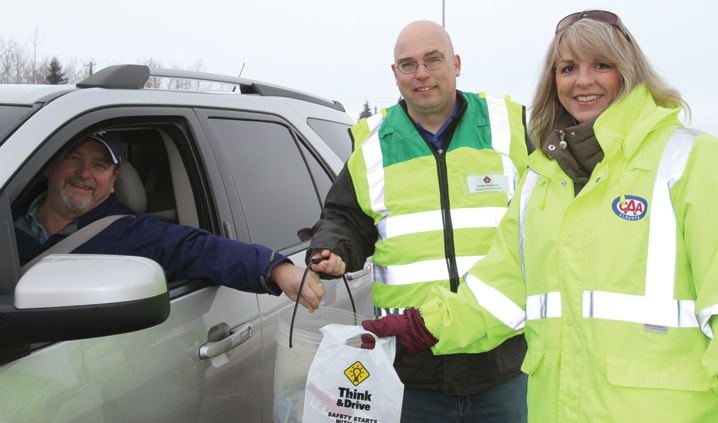Advocate reporter Paige Aarhus is in Africa for next two weeks with members of the Lacombe-based charity A Better World. She is filing stories about the people she meets and the issues they face. Today, she visits the Ian Castleman Orphanage. In part 2 of her examinati–on of Kenyan orphanages on Wednesday, she visits the East Africa Mission Orphanage.
NAKURU — Charity was seven years old when she was found in Nakuru National Park in Kenya. She was severely malnourished, didn’t speak and behaved more like an animal than a human.
Her sensational story broke in March 2007. Rangers reported the girl had been abandoned by her parents before she was a year old and raised by baboons in the park.
Charity is one of only a handful of feral children in the world — children who have lived isolated from human contact from a very young age, never experiencing human care, social behaviour, and without human language. Two years after she was found, the nine-year-old girl is still searching for her place in the world.
She’s small, thin and fidgety, and she seldom makes eye contact with others. Her left hand is forever in her mouth — staff at the Ian Castleman Orphanage rub cayenne pepper on it in a vain attempt to fix the problem.
She doesn’t speak, won’t play normal children’s games and she’s still flighty and solitary. But orphanage founder Ian Castleman of Australia said she’s come a long way from when she first arrived.
“When she came here, she went to the toilet everywhere. She wouldn’t sleep in a bed, she was screaming all night, you couldn’t put a blanket on her.”
Now you can see she shakes hands, she eats out of a dish when she used to slap it onto the floor. She’s making progress,” he said.
Charity is one of 25 severely disabled children who live at the orphanage. There’s simply not enough staff and resources to give every child the attention they need, but there’s nowhere else for them to go.
“I’ve cried to God real tears. I’ve turned away over 1,000 children. People come to me and they are pleading and weeping, but we have so many who need so much already,” said Castleman.
Take five-year-old Damarus. The girl was so severely neglected by her mother, who is now in jail, that she resembles a toddler more than a young child. Her growth is stunted, she weighs no more than 13 kg (30 pounds) and, like Charity, she can’t communicate or interact with other children. Her days are spent in a crib, where staff spend two hours feeding her at each meal. She will never walk.
Cases like Charity’s and Damarus’s are all too common at Ian Castleman. It’s one of the few orphanages in the Rift Valley province that accept disabled children, but with 130 kids, it is also overcrowded and running out of money.
Dark, musty dorms are jammed with three-bed bunks and there is no common eating area. A large concrete holding tank for water is uncovered — rainwater that falls goes green and unusable within a week.
Castleman has been squabbling with Canadian donors over the number of kids he has, the level of hygiene and the progress he’s making at his facility. He said he’s disappointed that his methods are questioned when all he’s trying to do is help the children.
“The people who rebuke me are the people who are not here. They don’t see what it’s really like,” he said.
It costs at least $8,000 a month to keep Castleman’s orphanage running with bare bones services. He said he’s been expecting new buildings, a lid for the water tank and a host of renovations from Lacombe charity A Better World, but they haven’t been forthcoming.
At the same time, he defends using much-needed resources to house a pet monkey in a large pen on site. Since he owns the land, Castleman said he should decide which buildings go where — meaning the area where new buildings were supposed to be constructed is home to unfinished straw visiting huts for children and parents instead.
Castleman said he’s managed to find enough money for food and supplies each month, and that many children have experienced significant improvements under his watch — in fact, he claims his healthy, sugar- and additive-free meals have cured six children at the orphanage of AIDS.
“Most people think it can’t be cured, but if that’s true then there is no God. Disease is a result of sin and disobedience. Clean living will bring redemption,” he said.
Eric Rajah, co-founder of A Better World, said he’s deeply concerned about the children at Castleman and the donors who have invested in the project.
“You have a man who has a big heart, but when you’re doing humanitarian work, your mind and your heart have to work together,” he said.
Capital projects have been put on hold at Castleman because Rajah wants a guarantee things will change. Until then, A Better World supports the children by paying for hospital care and physiotherapy, supplying baby formula and paying for students’ secondary school fees.
Rajah’s charity has gone to the Kenyan government with its concerns, and an independent inquiry into the practices at Castleman will be launched next week. Until then, he hopes donors in Alberta won’t give up on the kids who so desperately need their help.
“What breaks my heart is we exist to make things better, not to run away from problems, but when our donors invest money in projects, they expect that things will improve,” he said.
paarhus@www.reddeeradvocate.com
